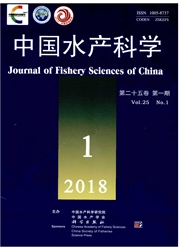

 中文摘要:
中文摘要:
本研究以长牡蛎(Crassostrea gigas)F1全同胞家系为作图群体,在已构建的基于120个微卫星和66个SNP标记的长牡蛎性别平均连锁图谱上,利用PROC QTL 2.0软件对出肉率和壳形(壳宽和壳深)性状进行QTL定位分析。结果表明,共检测到13个相关的QTL,分布在3个连锁群上;其中,与出肉率相关的4个QTL定位在1号和3号连锁群上(LG1和LG3),表型解释率为0.25%~47.53%;与壳宽相关的3个QTL定位在10号连锁群上(LG10),表型解释率为0.71%~45.39%;与壳深相关的6个QTL也定位在LG10,表型解释率为3.37%~24.78%。根据QTL连锁群分析和性状相关性分析结果可以推测,出肉率与糖原含量性状以及壳宽与壳深性状分别具有相近的遗传特征,利用与相关性状共同关联的分子标记可以同时对出肉率与糖原含量性状、壳宽与壳深性状进行遗传改良。本研究结果为今后长牡蛎相关性状候选基因克隆和分子标记辅助育种提供了参考。
 英文摘要:
英文摘要:
The Pacific oyster(Crassostrea gigas) is cultured worldwide, and the meat yield and shell shape (shell width and shell depth) are two of the most important economic traits of this species. The mapping population used in this study was an F1 full-sib family produced by mating a female parent from a second-generation strain selected for rapid growth in Japan with a male parent from a wild Chinese population. Eighty-three progeny were selected for linkage analysis in July 2009, and the meat yield, shell width, and shell depth traits were determined. The values for the shell width and shell depth traits were normally distributed, except meat yield, and these three traits were positively correlated. A genetic linkage map was constructed with 120 microsatellite and 66 single nucleotide polymorphisms (SNPs) from the F1 full-sib family. Based on the linkage map, PROC QTL 2.0 software was selected to perform a quantitative trait locus (QTL) analysis for the meat yield and shell shape (shell width and shell depth) traits under a four-way model using the maximum-likelihood method. The results show 13 related QTLs distributed on three linkage groups (LGs). Four QTLs were associated with meat yield on LG 1 and 3 and explained 0.25%-47.53% of the phenotypic variance. Three QTLs on LG10 were related to shell width and explained 0.71%-45.39% of the phenotypic variance. Six QTLs were identified for shell depth on LG10 and explained 3.37%-24.78% of the phenotypic variance. The results of the QTL linkage group and correlation analyses suggest that meat yield and glycogen content, and shell depth and shell width may have closely related genetic characteristics, and that the traits (meat yield and glycogen content, and shell depth and shell width) could be improved simultaneously when closely linked markers are used during breeding. These results provide a useful reference for further candidate gene research and molecular marker-assisted selection in the Pacific oyster.
 同期刊论文项目
同期刊论文项目
 同项目期刊论文
同项目期刊论文
 期刊信息
期刊信息
